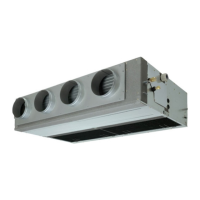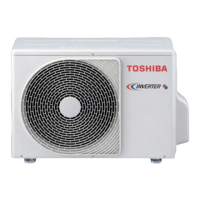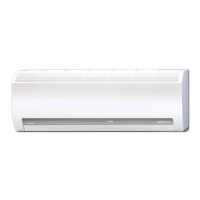Do you have a question about the Toshiba RAV-SM560KRT-E and is the answer not in the manual?
Includes the remote control unit for operating the air conditioner.
Component used for mounting the indoor unit.
Fasteners provided for securing the installation plate.
Crucial safety instructions for proper and safe installation.
Procedure for safely disconnecting the appliance from the mains supply.
Important safety guidelines to follow during normal operation.
Precautions to take when moving or repairing the unit.
Important cautions related to installation procedures and placement.
Key cautions for daily operation, usage, and environmental considerations.
Identification of parts and functions of the outdoor unit.
Identification of parts and functions of the indoor unit.
Explanation of the indicators on the display panel.
How to use the temporary operation button on the indoor unit.
Instructions for preparing and attaching air filters.
Detailed explanation of all items displayed on the unit's display.
Explanation of the controls found in the operation section.
Detailed functions of each button in the operation section.
Information regarding central remote controller integration and displays.
Steps to take before the first operation or after a long stop.
Essential requirements and considerations for operating the unit.
Procedure for correctly stopping the air conditioner.
Specific notes and timings related to cooling mode operation.
Specific notes and timings related to heating mode operation.
Details on how the unit behaves when restarting after a pause.
Steps to initiate the dry operation mode.
Procedure to stop the dry operation mode.
Steps to initiate the automatic operation mode.
Procedure to stop the automatic operation mode.
Methods for adjusting vertical air flow direction and swing.
Important cautions when adjusting air flow direction.
How to adjust the horizontal air flow direction manually.
Explanation of how the unit automatically selects operating modes.
How room temperature affects the unit's mode selection.
Importance and frequency of cleaning air filters for efficiency.
Advice on reducing heat/cool loss by limiting door and window openings.
Tips for using the timer function for optimal operation.
Adjusting airflow for even temperature distribution.
How to operate the unit without the remote controller.
Information on the filter indicator and how to reset it.
Crucial safety warning before performing any cleaning.
Instructions for cleaning the indoor unit and remote controller.
Precautions to avoid damage when cleaning unit components.
Steps for preparing the unit for storage exceeding one month.
Important cautions to check before operating the unit.
Step-by-step instructions for cleaning the air filters.
How to turn off the filter indicator lamp after cleaning.
Step-by-step instructions for cleaning the air inlet grille.
Explanation of the protection feature preventing immediate restarts.
Details on preheating, warm air control, and defrosting during heating.
How the unit warms up before delivering hot air.
How the unit manages warm air flow based on room temperature.
Explanation of the automatic defrosting process.
Considerations for heating performance in low outdoor temperatures.
How the unit behaves and restarts after a power interruption.
Recommended temperature ranges for optimal cooling and heating.
Safety warnings and initial checks before seeking service.
Guides for diagnosing and resolving common operational issues.
| Brand | Toshiba |
|---|---|
| Model | RAV-SM560KRT-E |
| Category | Air Conditioner |
| Language | English |












